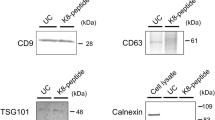Abstract
Membrane fractions were isolated from homogenates of an aminoazo dye induced rat hepatoma (hepatoma D23) by sucrose density gradient centrifugation in zonal rotors. The membrane fractions retained tumour specific antigenic determinants and exhibited an increased antigenic activity over other subcellular membrane fractions, as defined by their capacity to quantitatively neutralize the membrane immunofluorescence staining of viable hepatoma D23 cells by antibody in tumour immune serum. In contrast, no antigenic activity was found to be associated with purified hepatoma D23 nuclei or nuclear membranes as evaluated by the in vitro antigen assay.
The two methods described for the isolation of hepatoma D23 membranes have been developed for the large scale fractionation of tumour homogenates in order that further studies upon the nature and immunogenicity of membrane associated tumour specific antigens may be resolved using defined membrane preparations of increased antigenic activity.
This is a preview of subscription content, access via your institution
Access options
Subscribe to this journal
Receive 24 print issues and online access
$259.00 per year
only $10.79 per issue
Buy this article
- Purchase on Springer Link
- Instant access to full article PDF
Prices may be subject to local taxes which are calculated during checkout
Similar content being viewed by others
Rights and permissions
About this article
Cite this article
Price, M., Baldwin, R. Preparation of Aminoazo Dye Induced Rat Hepatoma Membrane Fractions Retaining Tumour Specific Antigen. Br J Cancer 30, 382–393 (1974). https://doi.org/10.1038/bjc.1974.212
Issue Date:
DOI: https://doi.org/10.1038/bjc.1974.212
This article is cited by
-
Application of a subcellular membrane-antibody binding assay for the analysis of antigen expression in human tumours
Journal of Cancer Research and Clinical Oncology (1986)
-
Immunogenicity of cellular and acellular antigen preparations from a methylcholanthrene-induced mouse sarcoma
Journal of Cancer Research and Clinical Oncology (1982)



